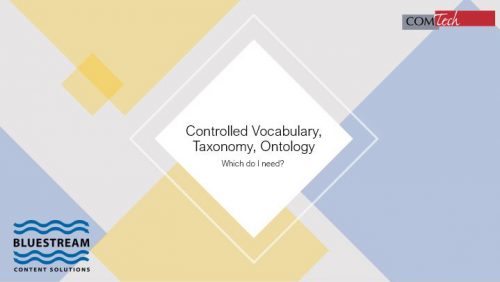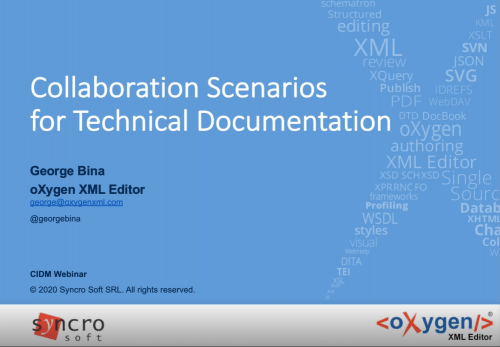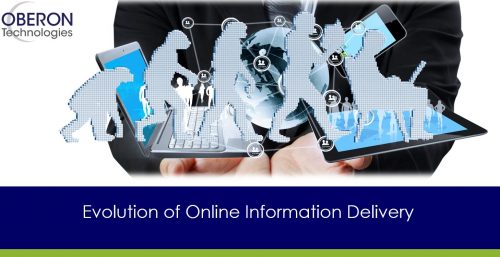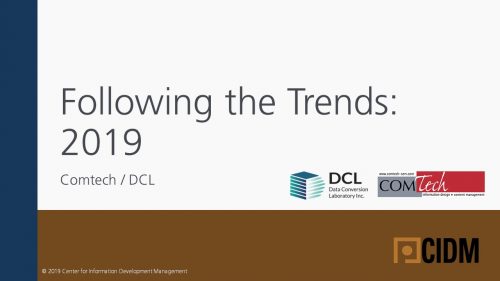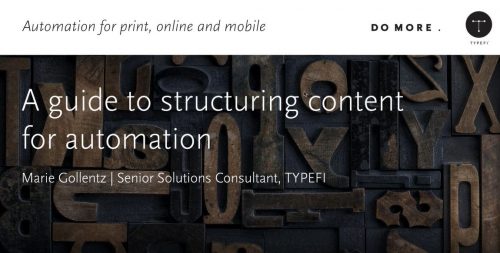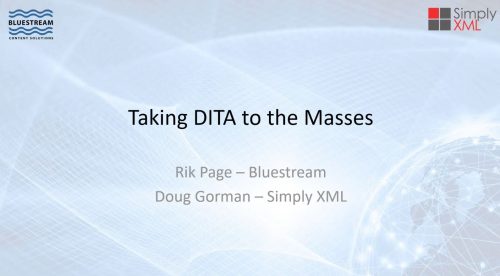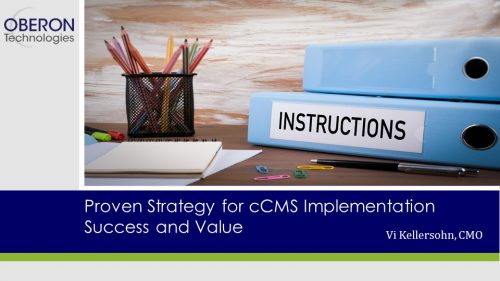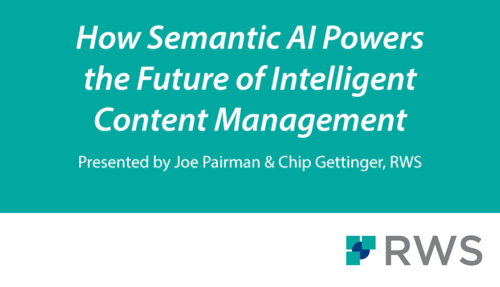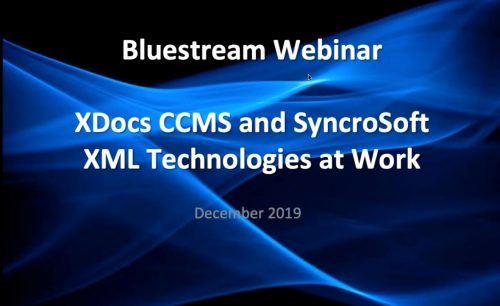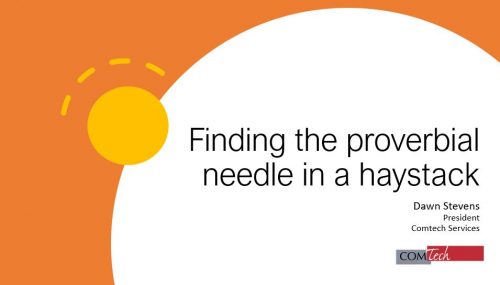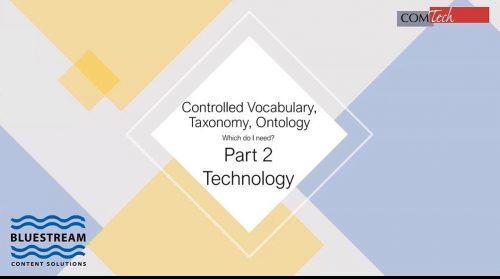-
March 9, 2021 Ironically, the terms utilized to describe a vocabulary of words used to organize and catalog information within a content corpus often are used inconsistently or interchangeably. However, each term represents a point, on an increasing scale of complexity and resulting data richness and applicability. In this two-part webinar, Dawn Stevens of Comtech Services defines key points along this scale, comparing and contrasting the scope and domain to which each term applies, suggesting when each might be used, and recommending the processes for creating it. Dawn is joined by Rik Page of Bluestream, who will demonstrate real-life examples of each in use. Participants will gain clarity about the approach required to make content more accessible for their users. View part 2 of this webinar here. Presented by: Dawn Stevens is the President, and owner of Comtech Services and the Director of the Center for Information-Development Management. With over 25 years of experience, including 20 years at Comtech, Dawn has practical experience in virtually every role within a documentation and training department, including project management, instructional design, writing, editing, and multimedia programming. With both engineering and technical communication degrees, Dawn combines a solid technical foundation with strong writing and design skills to identify and remove the challenges her clients face in producing usable, technical information and training. Rik Page is Sales and Marketing Director at Bluestream Software and has been working with both component content and document management solutions since 2001. During this time, he has worked with custom DTDs and Schemas, S1000D, iSpec2200 and since 2005 DITA. His practical experience ranges from data capture/content creation through to dynamic multichannel delivery, achieved in a wide range of industries including banking and finance, manufacturing, central government and education. A keen advocate of technology and innovation Rik has taken part in multiple consultancy projects and helped formulate solutions all over the world. Away from the office Rik is a Scout Leader working with young people and helping them to develop new skills whilst having fun.
-
March 4, 2020 Technical documentation is rarely created by lone writers, so there is a constant need for collaboration. Collaboration can be with other writers or with people with other roles, usually referred to as subject matter experts, who may be part of your organization or external experts. In order to be successful, the collaboration needs to be enabled by integrating it as part of the usual processes or workflows each user performs. In this presentation, we will explore a few collaboration scenarios that show how to implement continuous improvement loops for published documentation, how to integrate documentation as part of the product development workflow, and how immediate collaboration can take place. Presented by: George Bina is one of the founders of Syncro Soft SRL, the company that develops oXygen XML suite of XML editing, authoring, development, publishing and collaboration tools. He has more than 20 years of experience in working with XML and related technologies, bringing many innovative ideas to reality and contributing to XML-related open-source projects. He presented at many XML, DITA, and technical communication conferences, giving passionate presentations and challenging the technological status quo, trying to get the audience to think outside the box, and re-imagine the future.
-
May 21, 2019 As technology advances so do consumer expectations for online information access. No longer do users want to rely on printed materials nor are we satisfied with views of lengthy PDFs online. Consumers, both inside and outside your organization, want to quickly find just the information they need from any device. With the emergence of many connected products, virtual and augment reality the online information demands can be staggering. Is your documentation system ready to take you into the future? Find out how many organizations are taking steps to delivering better information today and prepare their organization to more easily evolve with technology advances and consumer demands. Attendees will learn: 1) What does the evolution of online delivery include? 2) How structured content impacts your future delivery options? 3) Why you don’t have to wait to begin improving your users’ online delivery experiences? Presented by: Vi Kellersohn is the Chief Marketing Officer of Oberon Technologies. Vi leads the marketing efforts, manages strategic partnerships and supports key client projects. For over 20 years Vi has managed and executed all aspects of marketing for B2B technology organizations working in partnership with sales management to build awareness for value opportunities across the content lifecycle. Vi enjoys spending time with her extended family and golfing with her husband and two sons.
-
April 30, 2019 Consumers have more avenues than ever before to find the content they need. Are you trying to decipher how content trends are impacting your business? Do you need to respond to a rapidly changing digital marketplace? Join us to discover how changing content development and delivery requirements are affecting your business today. Learn how others in the information-development community are planning to respond to new customer demands for innovative approaches to development and delivery. In its seventh year of collecting data, the Center for Information-Development Management (CIDM) and Data Conversion Laboratory (DCL) asked managers, information architects, writers, training developers, and more how they are addressing the challenges of meeting customer information needs. During the webinar we walk through the results of the 2019 Trends Survey, a study we have been conducting since 2012. We trace the changes in how we think about developing and delivering content. Presented by: Dawn Stevens, President, Comtech Services and Director of CIDM has 28 years of practical experience in virtually every role within a documentation and training department, including project management, instructional design, writing, editing, and multimedia programming. Dawn is the perfect advisor to identify and remove the challenges you face in producing usable, technical information and training content. With both engineering and technical communication degrees, Dawn combines her solid technical foundation with strong writing and design skills to lead our team of consultants and specialists in providing the expertise you need. Mark Gross, President, Data Conversion Laboratory, is a recognized authority on XML implementation and document conversion. Mark also serves as Project Executive, with overall responsibility for resource management and planning. Prior to joining DCL in 1981, Mark was with the consulting practice of Arthur Young & Co. Mark has a BS in Engineering from Columbia University and an MBA from New York University. He has also taught at the New York University Graduate School of Business, the New School, and Pace University. He is a frequent speaker on the topic of automated conversions to XML and SGML.
-
September 9, 2020 This is a presentation that provides an intersection between content and design. It is a high-level practical guide to analyzing your content, deciding what you want to do with it, developing style naming conventions, and developing editorial style guides, design style guides, and style templates. Once you get to that stage, you can then consider how content management systems, automation, and xml might fit into your publishing processes. Presented by: Marie Gollentz is a Senior Solutions Consultant focusing on the European market. Prior to joining Typefi, she held a number of positions in the publishing industry in London, including at the publisher of Research Fortnight and the London School of Business and Finance. Marie holds a Masters degree in European Political Sciences from the Autonomous University of Barcelona and a Bachelor’s degree in Political Sciences from Sciences Po Strasbourg. She is trilingual in English, French and Spanish.
-
Date: June 12, 2019 Abstract: Ever since DITA was first used, the greatest obstacle to adoption has been usability. Whilst technical authors have been prepared to learn the intricacies of DITA, others in the content creation lifecycle have been more obstinate. Bluestream together with Simply XML will show how the extensible XDocs CCMS can be integrated with clear browser and desktop authoring environments to allow subject matter experts to create and collaborate on content without ever having to see a tag. Presented by: Rik Page is Sales and Marketing Director at Bluestream Software and has been working with both component content and document management solutions since 2001. During this time he has worked with custom DTDs and Schemas, S1000D, iSpec2200 and DITA. His experience covers a wide range of industries including education, banking and finance, manufacturing and healthcare. A keen advocate of technology and innovation Rik has taken part in multiple consultancy projects and helped formulate solutions all over the world. Over more than two decades, Doug Gorman commercialized the structured writing methodology known as Information Mapping. In the process he realized that XML(DITA) could be used beyond Technical Publication Departments to modernize the enterprise content supply chain. The authoring and repository tools, however, would need to be easy to use. XML would need to be utilized but hidden “under the covers.” Simply XML’s authoring tool, Content Mapper, is a Word Plug-in where the author sees a Word User Interface and the CMS uses DITA XML. Content Mapper is designed for organizations that understand the value of XML as the content architecture, but with many of the 1 Billion plus non-technical authors who use MS Word on a PC. Content Mapper is integrated with Bluestream’s XDocs CCMS to help organizations achieve better content for readers with the important efficiencies of content reuse, single source publishing, and other process improvements.
-
August 10, 2020 Content developers and managers worldwide are coming together to share ideas and inspire each other at ConVEx in September. When first announced, we said ConVEx is not an online simulation of an in-person conference, but an immersive experience designed from the ground up to use our e-resources in the best possible way to bring you a wealth of ideas and information to support your efforts in defining and executing a comprehensive content strategy. During this Webinar, Dawn Stevens explains what we mean by this statement and what you can expect and gain from this new event format. We'll discuss the event format, the technology we'll use, and highlight the many networking activities provided. By the end of the Webinar, you'll know why you should attend ConVEx — it's an opportunity to have a positive experience, converge with others in the industry, focus your attention on industry issues, and magnify your value to your organization. Presented by: Dawn Stevens, President, Comtech Services and Director of CIDM has 28 years of practical experience in virtually every role within a documentation and training department, including project management, instructional design, writing, editing, and multimedia programming. Dawn is the perfect advisor to identify and remove the challenges you face in producing usable, technical information and training content. With both engineering and technical communication degrees, Dawn combines her solid technical foundation with strong writing and design skills to lead our team of consultants and specialists in providing the expertise you need.
-
October 9, 2019 Delivering a cCMS solution on time and on budget is critical, but it’s important to recognize that the cCMS is only one part of a successful content lifecycle strategy. Making sure your content can be leveraged across the enterprise and your system will be able to support future initiatives requires a comprehensive and proven plan. Having led hundreds of successful content solution implementations, Oberon understands the differences in the tools, processes and environments that must be considered. While each cCMS implementation plan may be unique, shaped by the specific needs of a given company, there are many common steps to success that everyone should follow. Whether you are looking to adopt cCMS for the first time or you’ve been using one for years, there are ways to ensure your system is optimized for success. Attend this webinar and find out what your plan should include. Presented by: Vi Kellersohn is the Chief Marketing Officer of Oberon Technologies. Vi leads the marketing efforts, manages strategic partnerships and supports key client projects. For over 20 years Vi has managed and executed all aspects of marketing for B2B technology organizations working in partnership with sales management to build awareness for value opportunities across the content lifecycle. Vi enjoys spending time with her extended family and golfing with her husband and two sons.
-
October 20, 2021 Semantics add unique benefits for content, especially within organizations utilizing structured content. Whether content is for detailed product documentation, polished marketing materials, or accurate, insightful employee enablement, all audiences gain by quickly finding what they want. While improving findability is key, providing accurate information recommendations dramatically increases relevancy with minimal use of personal data. From pages to personal assistants, reuse metrics to insights, content that connects to core semantics—the real-world ideas and objects it refers to—becomes truly intelligent. But, of course, benefits like this don't come from just pushing a button—or can they? During this webinar, Joe and Chip will discuss that while machine learning is a good start, it may not give customers the full value, clarity, or futureproofing required. So we challenged ourselves to productize a semantic AI approach that drives a polished end-user experience—and also appeals to busy editorial teams who care about quality but need to beat deadlines. We'll also examine emerging best practices for the practical adoption of semantic AI within your organization. Learn how RWS built a layered solution for Tridion, combining it with the power of semantic AI. These innovations fuse a powerful partnership of Tridion for content management excellence with PoolParty for taxonomy management. The results provide content teams with the power, automation, and accuracy of modern semantics with human validation. Presented by: Chip Gettinger is VP Global Solutions Consulting at RWS, managing a team that works with customers in maximizing global content with RWS. He has experience working with customers to develop global content strategies, business ROI adoption drivers, change management, and technology adoption for component content management systems. He speaks and blogs about customer successes working closely with industry standards, partners, and customers in technology solutions and deployments. Joe Pairman is Senior Product Manager, Tridion Docs. By looking at customers' underlying needs, and recognizing technical opportunities, he has built truly innovative solutions with strategic value. Joe designed and led the development of a personalized guidance app that helped millions of users without requiring any of their data. He also integrated a knowledge model with granular structured content to automatically give data integrators a broad overview of their available implementation options and next actions. Most recently, Joe brings the power of his first B2B product love –Tridion Docs – to a whole new market and user sector of smart specialists who don't have time to learn structured authoring. Product work is more than just building features – it's bringing people together to shape vision, plans, and priorities across the whole software lifecycle, in a way that keeps the original value when the ground situation inevitably changes. Joe has learned to get things done with solid, secure, engineering without losing track of the path to greater customer value.
-
December 4, 2019 In this webinar, Bluestream will show how advanced integration with oXygen Author and Editor throughout the content lifecycle can greatly help everyone involved in creating content. From content creation, review, branching and merging, release management and delivery via Oxygen Chemistry and Oxygen WebHelp Bluestream will show what the future is bringing. Presented by: Nenad Furtula a Partner, and VP of Sales and Marketing at Bluestream Database Software. Nenad has been working with XML and bringing XML related products to market for over 15 years. Currently his primary professional interest lies in building and socializing a DITA-enabled component content management system called XDocs. Nenad holds a BBA from Capilano University and MSc (Computer Science) from Dalhousie University.
-
August 26, 2021 With the plethora of content available to users today, it’s often a wonder that they are able to find any relevant information to their queries. In fact, it’s the most common complaint Comtech hears when conducting user studies for our clients: “I can’t find what I’m looking for in a reasonable amount of time.” What can we as technical writers do to address that complaint? We hear a lot about taxonomies and metadata and their potential influence in making our content more findable. However, Google uses over 200 ranking factors in its search algorithm that go well beyond this basic categorization. Surprisingly, a significant number of these ranking factors fall clearly within the realm of a technical writer’s responsibilities. In this rapid fire webinar, Dawn presents dozens of proven and speculative factors that you as a technical writer can address to optimize your content for findability. Presented by: Dawn Stevens is the President, and owner of Comtech Services and the Director of the Center for Information-Development Management. With over 32 years of experience, including 20 years at Comtech, Dawn has practical experience in virtually every role within a documentation and training department, including project management, instructional design, writing, editing, and multimedia programming. With both engineering and technical communication degrees, Dawn combines a solid technical foundation with strong writing and design skills to identify and remove the challenges her clients face in producing usable, technical information and training.
-
April 6, 2021 Ironically, the terms used to describe a vocabulary of words that organize and catalog information within a content corpus are often used inconsistently or interchangeably. However, each term represents a point on an increasing scale of complexity and resulting data richness and applicability. Following Part 1 of this webinar in which Dawn Stevens of Comtech Services defined and compared these points along the taxonomy spectrum (view part 1 recording), Rik Page of Bluestream now demonstrates the technology and tools that enable you to define and manage your terms and relationships, as well as those that consume what you have defined. Participants will see practical, real-life applications of the taxonomical concepts previously presented. Click here to download the reading list referenced during this webinar. Presented by: Dawn Stevens is the President, and owner of Comtech Services and the Director of the Center for Information-Development Management. With over 25 years of experience, including 20 years at Comtech, Dawn has practical experience in virtually every role within a documentation and training department, including project management, instructional design, writing, editing, and multimedia programming. With both engineering and technical communication degrees, Dawn combines a solid technical foundation with strong writing and design skills to identify and remove the challenges her clients face in producing usable, technical information and training. Rik Page is Sales and Marketing Director at Bluestream Software and has been working with both component content and document management solutions since 2001. During this time, he has worked with custom DTDs and Schemas, S1000D, iSpec2200 and since 2005 DITA. His practical experience ranges from data capture/content creation through to dynamic multichannel delivery, achieved in a wide range of industries including banking and finance, manufacturing, central government and education. A keen advocate of technology and innovation Rik has taken part in multiple consultancy projects and helped formulate solutions all over the world. Away from the office Rik is a Scout Leader working with young people and helping them to develop new skills whilst having fun.

